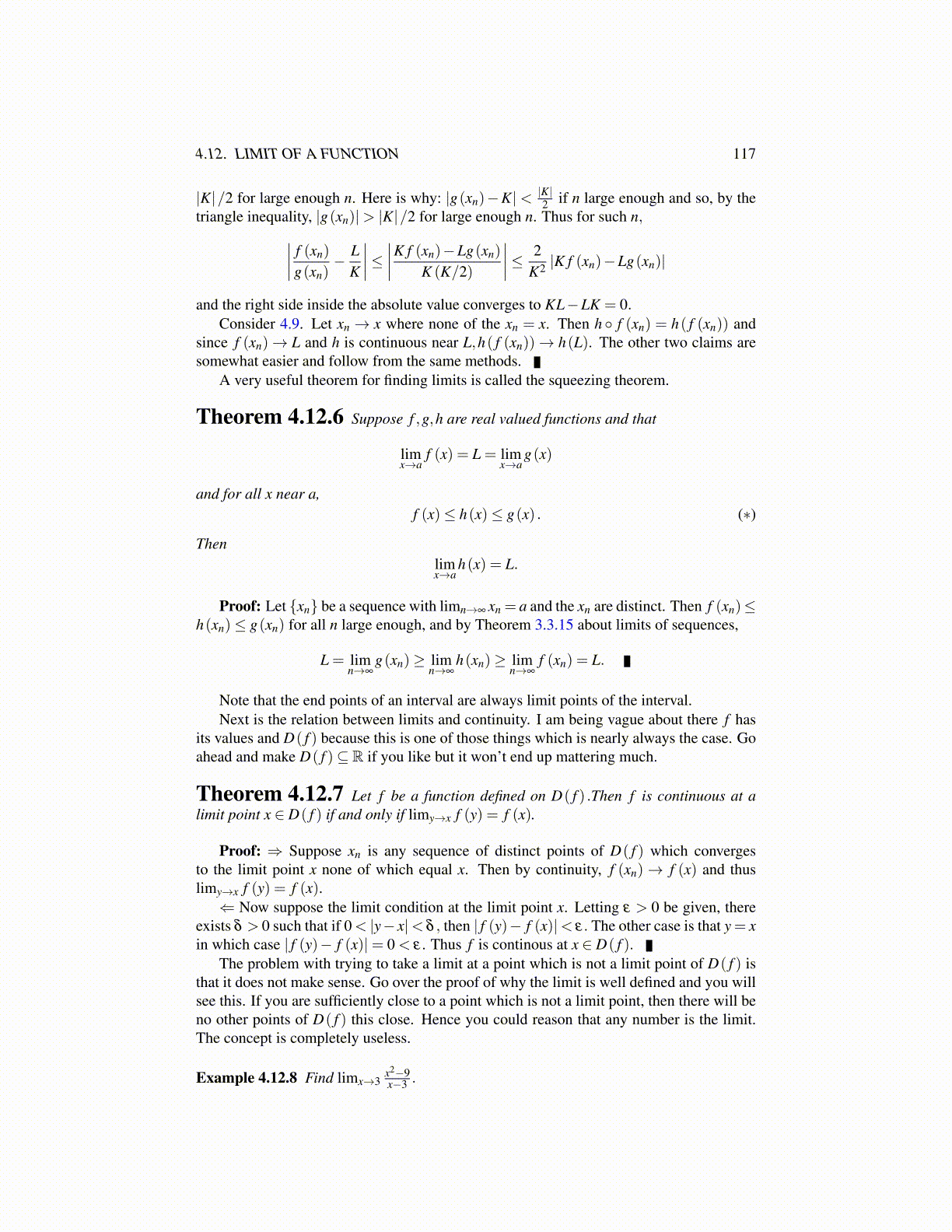
4.12. LIMIT OF A FUNCTION 117
|K|/2 for large enough n. Here is why: |g(xn)−K|< |K|2 if n large enough and so, by the
triangle inequality, |g(xn)|> |K|/2 for large enough n. Thus for such n,∣∣∣∣ f (xn)
g(xn)− L
K
∣∣∣∣≤ ∣∣∣∣K f (xn)−Lg(xn)
K (K/2)
∣∣∣∣≤ 2K2 |K f (xn)−Lg(xn)|
and the right side inside the absolute value converges to KL−LK = 0.Consider 4.9. Let xn → x where none of the xn = x. Then h ◦ f (xn) = h( f (xn)) and
since f (xn)→ L and h is continuous near L,h( f (xn))→ h(L). The other two claims aresomewhat easier and follow from the same methods.
A very useful theorem for finding limits is called the squeezing theorem.
Theorem 4.12.6 Suppose f ,g,h are real valued functions and that
limx→a
f (x) = L = limx→a
g(x)
and for all x near a,f (x)≤ h(x)≤ g(x) . (∗)
Thenlimx→a
h(x) = L.
Proof: Let {xn} be a sequence with limn→∞ xn = a and the xn are distinct. Then f (xn)≤h(xn)≤ g(xn) for all n large enough, and by Theorem 3.3.15 about limits of sequences,
L = limn→∞
g(xn)≥ limn→∞
h(xn)≥ limn→∞
f (xn) = L.
Note that the end points of an interval are always limit points of the interval.Next is the relation between limits and continuity. I am being vague about there f has
its values and D( f ) because this is one of those things which is nearly always the case. Goahead and make D( f )⊆ R if you like but it won’t end up mattering much.
Theorem 4.12.7 Let f be a function defined on D( f ) .Then f is continuous at alimit point x ∈ D( f ) if and only if limy→x f (y) = f (x).
Proof: ⇒ Suppose xn is any sequence of distinct points of D( f ) which convergesto the limit point x none of which equal x. Then by continuity, f (xn) → f (x) and thuslimy→x f (y) = f (x).
⇐ Now suppose the limit condition at the limit point x. Letting ε > 0 be given, thereexists δ > 0 such that if 0 < |y− x|< δ , then | f (y)− f (x)|< ε. The other case is that y = xin which case | f (y)− f (x)|= 0 < ε . Thus f is continous at x ∈ D( f ).
The problem with trying to take a limit at a point which is not a limit point of D( f ) isthat it does not make sense. Go over the proof of why the limit is well defined and you willsee this. If you are sufficiently close to a point which is not a limit point, then there will beno other points of D( f ) this close. Hence you could reason that any number is the limit.The concept is completely useless.
Example 4.12.8 Find limx→3x2−9x−3 .